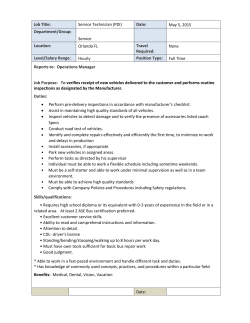
% reviewed paper Bridging the Gap in E-Mobility: from
reviewed paper Bridging the Gap in E-Mobility: from Supranational Goals to Local Legal Barriers to New Market Opportunities Heimo Aichmaier, Bertram Ludwig (Graduate Engineer, Heimo Aichmaier, Austrian Mobile Power, heimo.aichmaier@austrian-mobile-power.at) (Graduate Engineer, Bertram Ludwig, Austrian Mobile Power, bertram.ludwig@austrian-mobile-power.at) 1 ABSTRACT Supranational, national and local goals clearly set the agenda for low-emission transport in urban and suburban areas. If no clear incentives are given on a nationwide or local scope, only “early adopters” implement e-mobility. Often it turns out that local authorities, respectively local regulations and laws are hindering emobility rather than technology itself. How the gap from supranational goals to urban barriers can be overcome and new market opportunities will be created is the core element of the following paper. 2 FROM SUPRANATIONAL GOALS TO LOCAL IMPLEMENTATION 2.1 Supranational and National Goals – Setting the Path for the Future and the Presence A significant number of supranational goals are clearly setting the future agenda of motorized traffic, both passenger and freight traffic. In terms of e-mobility most notably the European White Paper on transport which aims to “halve the use of of ‘conventionally-fuelled’ cars in urban transport by 2030; phase them out in cities by 2050; achieve essentially CO2-free city logistics in major urban centres by 2030”(1) and marking therewith another important milestone to achieve the EU-2020 goals(2). These general goals of reducing emissions in urban areas are backed up by different regulations of the European Union like 333/2014(3) targeting the reduction of CO2 emissions of new passenger vehicles, 540/2014(4) aiming at a reduction of motor vehicle noise emissions as well as directive 2014/94(5) on the deployment of alternative fuels and infrastructure. In the case of e-mobility these supranational goals are supported by a set of national as well as urban goals, like in the case of the city of Vienna (Austria) the “Urban Development Plan Vienna. STEP 2025”(6) aiming at a higher share of electric freight vehicles in the city of Vienna. All do have in common the reduction of emissions from transport and consistently lead to a set of measurements which need to be implemented in urban and sub-urban areas. As e-mobility vehicles and emobility charging infrastructure have become suitable for everyday use as role models like Norway and the Netherlands have shown, often local barriers (e.g. building laws) are challenging the expansion of e-mobility as will be shown in this paper. Fig. 1. Share of new registered electric vehicles. Proceedings REAL CORP 2015 Tagungsband 5-7 May 2015,Ghent, Belgium. http://www.corp.at ISBN: 978-3-9503110-8-2 (CD-ROM); ISBN: 978-3-9503110-9-9 (Print) Editors: M. SCHRENK, V. V. POPOVICH, P. ZEILE, P. ELISEI, C. BEYER 101 Bridging the Gap in E-Mobility: from Supranational Goals to Local Legal Barriers to New Market Opportunities 2.2 E-Mobility in urban and sub-urban areas The daily average kilometres per private passenger vehicle in Austria are about 35 km(8) , vehicles used by the City of Vienna do have an average annual mileage of 7.000 km. For different purposes the industry nowadays provides different low emission vehicles: Battery Electric Vehicles fully cover driving distances within urban and sub-urban areas; Fuell Cell Electric Vehicles, PlugIn Hybrid Electric Vehicles and Range Extender Vehicles are in other cases more suitable for daily commuters. In addition to the developments in the field of automotive technologies also a broad selection of interoperable, intelligent charging infrastructure for different purposes already is available at the market: slow charging (>3,7 kW), accelerated charging (>20 kW) and fast charging (>43 kW) make charging easy and quick. The expected future distribution of e-charging stations is shown in figure 2. Fig. 2: Anticipated e-charging station distribution. With such a broad offer of different vehicle and charging technologies available all types of user demands can already be fully covered. For example freight vehicles in urban areas can be fully recharged in public accessible areas within less then 30 minutes during a coffee break. In the case of daily commuting charging infrastructure at the workplace and at the place of residence allow users to fully recharge their electric vehicle within a maximum of 8 hours. Vehicles with full electric driving ranges from 50 km up to 500 km show that the supranational goal of urban emission free traffic can be achieved already today and electric vehicles could already today play a major role in urban traffic. 2.3 The presence for users E-mobility is fully applicable for everyday use as the “virtual” example below shows: Joe Early is mostly using public transport to commute to work, but due to some luggage he is carrying today he is opting for his private car. He has been using a Battery Electric Vehicle for more than 2 years already and enjoys the convenience of charging his car at his apartment home. He is sharing his charging station (“wallbox”) with Jane Now, his neighbour. For making sharing of infrastrucutre and accounting of consumption of electricity easier they use an “intelligence wallbox” which fulfils all technical requirements of the European Union Regulation 2014/94(5) . By fulfilling these standards their charging station could also be accessible for other users in their apartment home and even for users from “outside”. Joe Early can also easily charge his car at his workplace; both charging stations at his workplace and at his residence place are for accelerated charging and therewith fully satisfy his needs: charging an electric vehicle within less than 4 hours. Joe Early´s employee (Green Vif Ltd.) describes himself as an urban pioneer company and is interested in new market opportunities for green technologies, hence Green Vif Ltd. applied for an ID for their charging infrastructure. Such an ID gives Green Vif Ltd. the opportunity to ensure that all technical requirements are in line with supranational regulations and to become part of a Europe-wide charging network. Therewith Green Vif Ltd. also builds the base for roaming and the opportunity to sell the 102 REAL CORP 2015: PLAN TOGETHER – RIGHT NOW – OVERALL Heimo Aichmaier, Bertram Ludwig use of e-charging infrastructure to non-employees. Joe Early and Jane Now also thought about applying for an ID but both still think that there are too many barriers for electric vehicle users so they postponed their application. 2.4 Legislative barriers to overcome As has been highlighted so far, technology for the use of electric vehicles in urban and suburban areas is ready but mainly used by “early adopters” rather than by “Joe Average”. But what are the obstacles which hinder the market penetration of e-mobility in urban and sub-urban areas? Beside fiscal incentives, which do have a strong influence on the share of electric vehicles (see also figure 1) potential users of e-mobility are often confronted with barriers hindering the implementation and operation of charging infrastructure. The implementation of new technologies, like charging infrastructure often contradicts existing regulations, e.g. building laws. For example the ex post implementation of charging infrastructure in underground garages in apartment homes contradicts with old – but still existing – building laws not allowing the parking and charging of electric vehicles with lead-acid batteries (modern electric vehicles are run by Li-Ion batteries and do not emit any gas as do lead-acid battery run vehicles). Due to this and other outdated regulations it can take up to 12 months to implement charging infrastructure in apartment homes. Such time and “energy” consuming barriers make it difficult for “non-early adopters” to opt for electric vehicles. Alongside the ex post implementation of charging infrastructure in real estates another important leverage for electro-mobility in urban areas are future real estate projects. Here building law play an important role for new technologies, e.g. e-mobility. For example compulsory conduits for later cabling as well as mandatory numbers of charging infrastructure per parking lot can have a major impact on the demand of e-vehicles and charging infrastructure. If such regulations are not compulsory, the circumstances for electric vehicles will remain hostile. Beside the private use of electric vehicles the use of electric freight vehicles is often also hindered due to the same reason discussed above. In addition electric freight vehicles also lack fast charging infrastructure in urban public space due to high investement costs for construction works and connection for power supply as well as regulations which are not supporting the change towards eco-friendly technologies. Due to these circumstances, e-mobility is mainly of interest for early adopters and still needs a lot of personal commitment. To overcome the gap between supranational goals and the local implementation more efforts are needed on an urban level. Efforts which should be reflected in building laws, operating charging infrastructure and other incentives (e.g. tax) to support new technologies. 3 CONCLUSION – WHAT CAN BE GAINED What will be achieved if these barriers on a local level can be overcome? • By easing the (ex post) implementation of charging infrastructure more charging infrastructure will be requested and subsequently the demand for electric vehicles will most likely increase. • State-of-the art infrastructure already is interoperable and therewith (according to EU directive 2014/94(5)) accessible for different user groups. However, as users are facing legal barriers in terms of constructing charging infrastructure return of investment is difficult to achieve. • If the legal framework would ease the implementation of charging infrastructure also new business opportunities for private and business operators of charging infrastructure could be expanded by giving them the opportunity to sell their services (charging, parking) to other electric vehicle users. • Cities in Europe are implementing different strategies for reducing the number of on-street-parking. Still, the number of vacant parking lots in real estate in some cities is up to 70 %(9). By constructing a higher number of charging infrastructure in parking garages this number could be successfully reduced. Consequently there would be less on-street-parking giving the opportunity to re-use public space formerly used for on-street-parking. • As was highlighted in 2.1. supranational and urban goals clearly describe the future path. The market is ready too and offering a diverse range of products, yet the quick amendment of legal framework on an urban scale is needed to allow new technologies to become profitable. Proceedings REAL CORP 2015 Tagungsband 5-7 May 2015,Ghent, Belgium. http://www.corp.at ISBN: 978-3-9503110-8-2 (CD-ROM); ISBN: 978-3-9503110-9-9 (Print) Editors: M. SCHRENK, V. V. POPOVICH, P. ZEILE, P. ELISEI, C. BEYER 103 Bridging the Gap in E-Mobility: from Supranational Goals to Local Legal Barriers to New Market Opportunities What is clearly missing is the adoption of the legal framework to help implementing new technologies. Supranational and local goals can only be achieved if authorities in urban and sub-urban areas implement supporting legal framework to overcome out-dated regulations and smooth the way for e-mobility and consequently a better environment. 4 REFERENCES (1) EUROPEAN COMMISSION, White Paper Roadmap o a Single European Transport Area, Brussels 2011. http://eurlex.europa.eu/legal-content/EN/TXT/HTML/?uri=CELEX:52011DC0144&from=EN, 20.02.2015 (2) EUROPEAN COMMISSION, Brussels 2012. http://ec.europa.eu/europe2020/europe-2020-in-a-nutshell/targets/index_en.htm, 20.02.2015 (3) EUROPEAN PARLIAMENT, Regulation 333/2014, Brussels, 2014. http://eur-lex.europa.eu/legalcontent/EN/TXT/HTML/?uri=CELEX:32014R0333&from=EN, 20.02.2015 (4) EUROPEAN PARLIAMENT, Regulation 540/2014, Brussels 2014. http://eur-lex.europa.eu/legalcontent/EN/TXT/?uri=uriserv:OJ.L_.2014.158.01.0131.01.ENG, 20.02.2015 (5) EUROPEAN PARLIAMENT, Directive 2014/94/EU, Brussels, 2014. http://eur-lex.europa.eu/legalcontent/EN/TXT/HTML/?uri=CELEX:32014L0094&from=DE, 20.02.2015 (6) CITY OF VIENNA, Urban Development Plan Vienna 2025. https://www.wien.gv.at/stadtentwicklung/studien/b008379.html, 20.02.2015 (7) Der Standard, Martin Putschögl: Sozialbau AG. „Talsohle im Neubau erreicht“. Vienna 2012 http://derstandard.at/1339639878198/Sozialbau-AG-Talsohle-im-Neubau-erreicht, 20.03.2015 (8) EUROPEAN PARLIAMENT, Directive 2014/94/EU, Brussels, 2014. http://eur-lex.europa.eu/legalcontent/EN/TXT/HTML/?uri=CELEX:32014L0094&from=DE, 20.02.2015 (9) STATISTICS AUSTRIA, Verkehr, Vienna, 2013. http://www.statistik.at/web_de/statistiken/verkehr/index.html, 02.03.2015 Figure 1: Share of new registered electric vehicles. Source: RDC inMotiv Nederland B.V., Opplysningsrådet for Veitrafikken AS, Statistics Austria. Calculation by Austrian Mobile Power, 2013. Figure 2: Anticipated e-charging station distribution. Source: Austrian Mobile Power, 2014. 104 REAL CORP 2015: PLAN TOGETHER – RIGHT NOW – OVERALL
© Copyright 2025









